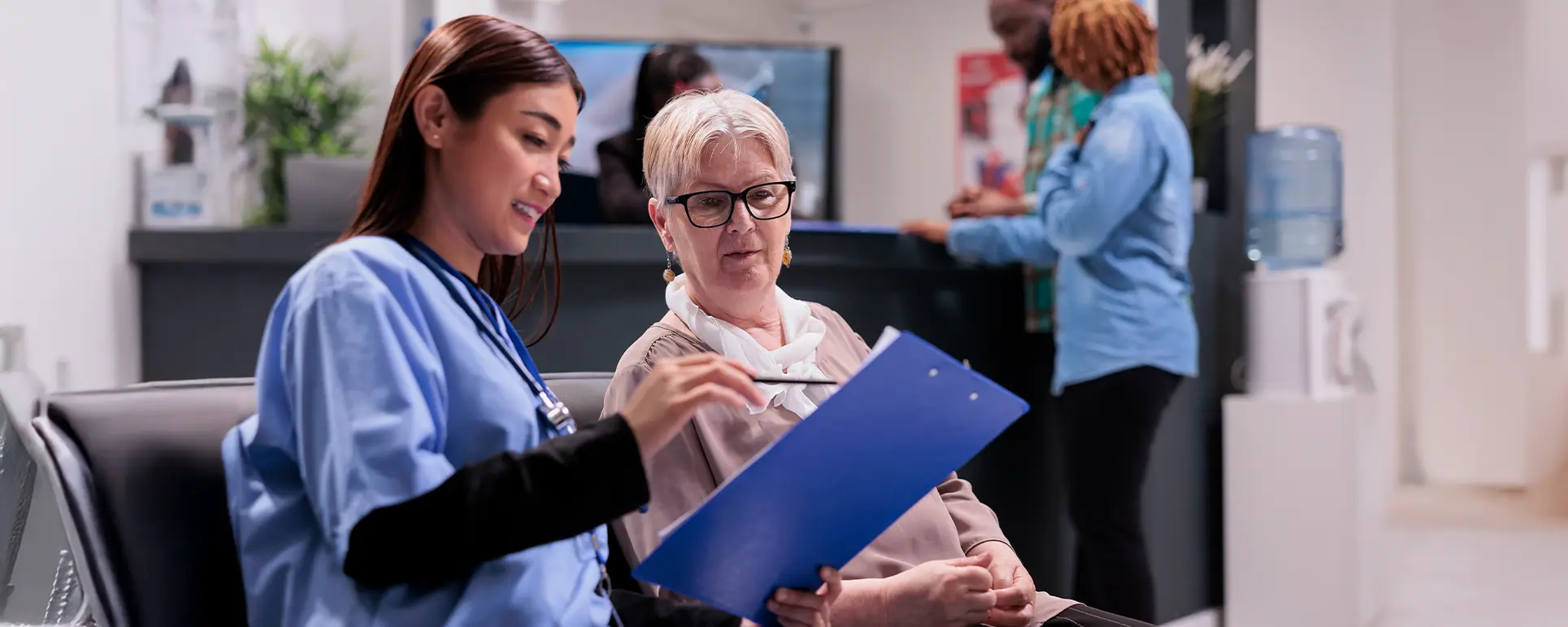When we talk about cataract surgery, we often focus on the technical side—lens power calculations, surgical precision, and complication rates. But here’s a question worth asking: how does the patient actually feel after the procedure? That’s where Patient-Reported Outcome Measures, or PROMs, come into play.
PROMs are helping us shift from a purely clinical lens to one that truly reflects the patient’s experience. They offer a direct window into how cataract surgery impacts vision, satisfaction, and quality of life. And increasingly, they’re becoming central to how we evaluate success—not just in trials but in day-to-day care.
What Are PROMs and Why Do They Matter?
Let’s start with the basics. PROMs are standardised questionnaires that patients complete to report how they feel about their health condition and the impact of treatments. These are not assessments made by doctors or technicians—they come straight from the patients themselves. In the context of cataract surgery, PROMs might ask about improvements in daily tasks, such as reading or driving, as well as overall satisfaction and emotional wellbeing.
Why is this important? Because 20/20 vision on a chart doesn’t always translate to a satisfied patient. Two people might have identical surgical outcomes on paper but report vastly different experiences. PROMs give us that richer, more nuanced insight into what success really looks like through the patient’s eyes.
Visual Acuity vs Visual Function: Not the Same Thing
Traditionally, cataract surgery outcomes have been judged by visual acuity—how clearly someone can read an eye chart. That’s useful, but limited. Visual function goes further. It looks at how vision affects real-world tasks, like recognising faces, navigating unfamiliar environments, or watching television comfortably. PROMs fill this gap by asking patients directly about the vision-related activities that matter most to them.
For example, someone might achieve excellent acuity but still struggle with night driving due to glare or halos. A PROM can pick that up, whereas a standard test might not. This level of insight is invaluable—not just for individual patient care, but also for improving techniques and technologies more broadly.
Common PROMs Used in Cataract Surgery Studies
Several validated tools are widely used in cataract research. The most well-known is the Catquest-9SF, a short questionnaire that explores the impact of cataract surgery on everyday activities. It’s simple, quick to complete, and has been translated into multiple languages for global use.
Another commonly used PROM is the National Eye Institute Visual Function Questionnaire (NEI VFQ-25). This one goes deeper, assessing not just functional vision but also emotional responses to vision problems. It’s especially useful in studies comparing different intraocular lens (IOL) types or surgical approaches.
There’s also growing interest in condition-specific measures, such as those tailored for patients receiving multifocal or toric lenses. These PROMs help fine-tune our understanding of patient experiences with newer technologies, which don’t always show clear-cut advantages on standard vision tests.
How PROMs Are Integrated Into Clinical Trials
PROMs have become a staple in high-quality cataract surgery research. In many randomised controlled trials, they’re used alongside traditional clinical metrics to provide a more rounded picture of outcomes. Researchers typically collect PROMs data at multiple time points—pre-surgery, shortly after surgery, and several months down the line—to capture both immediate and longer-term effects.

What’s especially interesting is how PROMs can reveal subtle differences between interventions. For example, while two lens types might yield similar visual acuity, PROMs could show that one consistently leads to better night vision or greater reading comfort. That kind of insight can influence clinical recommendations, product design, and patient decision-making.
PROMs in Evaluating Surgical Techniques
PROMs are also shedding light on how different surgical techniques affect patient experience. Take femtosecond laser-assisted cataract surgery (FLACS), for instance. Some studies have shown only marginal improvements in visual acuity compared to manual techniques. But when PROMs are included, patients sometimes report a smoother recovery, less discomfort, or better early vision with FLACS.
These findings underscore the value of patient-centred data. It’s not just about what the microscope sees—it’s about what the patient lives with. As surgical methods evolve, PROMs help us understand whether those advances truly make a difference where it counts most.
Assessing Premium Lenses with PROMs
Premium intraocular lenses—like multifocal, trifocal, and extended depth of focus (EDOF) lenses—are marketed with the promise of spectacle independence and improved vision at multiple distances. But how well do they actually deliver?
PROMs play a crucial role here. They can capture patient satisfaction, the frequency of visual disturbances, and quality of life improvements in ways that basic vision testing can’t. Studies using PROMs have revealed that while some patients thrive with premium lenses, others report bothersome side effects like glare or reduced contrast sensitivity—insights that might be missed in a traditional clinical setup.
This information empowers patients to make more informed choices and helps surgeons tailor their recommendations based on individual needs and expectations.
The Role of PROMs in Public Health and Policy
Beyond individual care, PROMs have a major role to play in public health and policy. Healthcare systems are increasingly using PROMs to evaluate service quality and allocate resources. For example, in the UK’s NHS, PROMs data helps inform commissioning decisions and benchmark performance between hospitals.
This is particularly relevant in cataract surgery, which is one of the most common procedures performed in the NHS. Collecting PROMs on a large scale allows health services to assess not just how many operations are being done, but how well they’re improving lives. That’s a more meaningful measure of success and one that aligns better with patient-centred care.
How PROMs Inform Postoperative Care and Long-Term Follow-Up
One of the most immediate benefits of PROMs is how they can fine-tune a patient’s postoperative care. While most cataract patients achieve excellent clinical outcomes, a subset may feel that their vision hasn’t improved as much as expected. PROMs can highlight these gaps early on.
For example, a patient may report difficulty reading despite good distance acuity or mention bothersome glare when driving at night. These insights help clinicians intervene quickly, whether through optical correction, further explanation, or additional assessments to rule out secondary issues like posterior capsule opacification.
Beyond short-term care, PROMs are also valuable in monitoring long-term satisfaction and vision stability. Many patients experience changes in how they perceive their vision over time, influenced by factors like lens adaptation, ocular surface health, or co-existing conditions like dry eye or macular degeneration. By collecting PROMs at regular intervals—say, at one month, six months, and one year—clinics can spot deteriorations or plateaus in patient-reported quality of life that might otherwise go unnoticed in routine follow-up appointments. This opens the door to more proactive, tailored support for individual patients.
Crucially, this approach also helps manage expectations. Cataract patients often have high hopes for immediate visual freedom, particularly with premium IOLs. When PROMs reveal a pattern of initial dissatisfaction that later resolves, it can inform better preoperative counselling.
Surgeons can explain that it’s common for certain symptoms—like halos or minor blur—to improve with time, reducing anxiety and improving compliance with the recovery process. In essence, PROMs create a feedback loop that improves both clinical outcomes and patient communication.
PROMs in Comparative Effectiveness Research
PROMs are becoming increasingly valuable in comparative effectiveness research, which seeks to determine not just whether treatments work, but how they perform relative to other options in real-world conditions. In cataract surgery, this is particularly relevant when evaluating different types of intraocular lenses, surgical techniques, or pre- and postoperative care protocols.
PROMs add the patient perspective into these evaluations, showing which choices actually lead to better quality of life from the patient’s point of view—not just better acuity on a chart.
For instance, a clinical trial might find that two types of lenses both yield good visual acuity at distance. However, PROMs may uncover that one lens type leads to more complaints about near vision difficulty or night-time glare.
These seemingly minor distinctions can make a world of difference to patients, especially when the goal is to reduce spectacle dependence or return quickly to driving and reading. Researchers can then identify trends that would be invisible through clinical metrics alone, allowing recommendations to be more nuanced and patient-focused.
This kind of data is also influencing policy and purchasing decisions. Health systems and insurers are increasingly turning to PROMs to determine value for money. A lens that costs more but offers greater long-term satisfaction—as measured by PROMs—might be favoured over a cheaper alternative that leads to more follow-up visits or patient complaints. PROMs thus serve not only as a research tool but also as a driver of evidence-based decision-making at the institutional and governmental levels.

Integrating PROMs into Digital Cataract Surgery Pathways
As healthcare becomes more digital, PROMs are being adapted to fit into increasingly streamlined cataract care pathways. Traditionally, PROMs were paper-based and collected at limited intervals, often only as part of research trials.
Today, however, clinics can embed PROMs directly into the patient journey using electronic health records (EHRs), online forms, and mobile apps. Patients can complete questionnaires at home before their surgery and at key milestones afterward, making the process far more efficient and consistent.
This integration has several advantages. For one, it reduces the administrative burden on staff. Front-desk teams no longer need to hand out forms or manually enter data. Digital PROMs also support automation, meaning results can be flagged automatically if they suggest post-op dissatisfaction or a need for follow-up.
For example, if a patient reports poor night vision one month after surgery, that information can trigger an alert to the clinical team, allowing them to offer support or intervention quickly. The ability to respond in real time enhances safety, satisfaction, and care continuity.
Moreover, digitising PROMs opens up opportunities for big data analytics. Clinics and health systems can track patterns across hundreds or thousands of patients, identifying trends related to specific lenses, demographics, or surgical approaches.
This can help refine protocols, reduce unwanted variation in care, and personalise treatment recommendations based on what’s worked best for similar patients in the past. Ultimately, by embracing digital integration, we can make PROMs not just a data collection tool, but a dynamic component of responsive, high-quality cataract care.
Challenges in PROMs Implementation
Despite their value, PROMs aren’t without challenges. One issue is ensuring the questionnaires are accessible to all patients, including those with low literacy or cognitive difficulties. Translations need to be accurate and culturally appropriate, and digital formats must be user-friendly for older adults who may not be tech-savvy.
Another hurdle is integrating PROMs into routine clinical workflows. It’s one thing to use them in trials, but embedding them into everyday practice can be tricky. Time constraints, lack of training, and data management issues often stand in the way. However, with electronic health records becoming more advanced, there’s growing potential to make PROMs a standard part of post-op care.
Using PROMs to Identify and Address Dissatisfaction
One of the most valuable uses of PROMs is picking up dissatisfaction early. Not every surgery goes as expected, and even a technically perfect procedure might leave a patient underwhelmed. PROMs can help flag these cases before they escalate into complaints or negative reviews.
If a patient reports persistent glare or reading difficulty post-surgery, that insight can guide follow-up care—perhaps a change in glasses, further counselling, or even additional treatment. PROMs offer a structured way to ask, “How are you doing?”—and to respond meaningfully when the answer is, “Not great.”
PROMs and Shared Decision-Making
Shared decision-making is a big buzzword in modern healthcare, and rightly so. Patients should be partners in their own treatment plans. PROMs support this by clarifying patient priorities and expectations before surgery. If someone values near vision over distance vision, or is particularly sensitive to night-time glare, that can shape the surgical plan from the outset.
PROMs give patients a voice in what matters most to them—before, during, and after surgery. They don’t just measure outcomes; they shape them.
Future Directions: Custom PROMs and Real-Time Data
Looking ahead, we’re likely to see more personalised PROMs tailored to individual needs or device types. Real-time data collection through apps or wearable devices could also become a game-changer, allowing clinicians to track recovery and satisfaction more dynamically.
There’s also potential for AI to help analyse PROMs data, identifying patterns and predicting which patients might benefit from certain lenses or techniques. The goal? Smarter, more tailored cataract care—driven by the people it’s meant to help.
Final Thoughts
Cataract surgery is one of the most effective procedures in modern medicine—but its success shouldn’t just be judged by what the surgeon sees under the microscope. PROMs shift the focus to what the patient sees, feels, and experiences. They capture the human side of surgery, turning outcomes into stories that matter.
Whether it’s in clinical trials, routine care, or national policy, PROMs are changing how we define good cataract surgery. They’re not just a data point—they’re a conversation. And in that conversation, the patient’s voice is finally being heard.

References:
- Lundström, M., Pesudovs, K. and Questionnaires in Cataract Research Group, 2009. Questionnaires for measuring patient-reported outcomes in cataract surgery. Journal of Cataract and Refractive Surgery, 35(2), pp.319–328.
- Black, N., 2013. Patient reported outcome measures could help transform healthcare. BMJ, 346, p.f167. Available at: https://www.bmj.com/content/346/bmj.f167
- Khadka, J., McAlinden, C. and Pesudovs, K., 2013. Quality assessment of ophthalmic questionnaires: review and recommendations. Optometry and Vision Science, 90(8), pp.720–744.
- Dean, W.H., Buchan, J.C., Fox, S., Jones, N.P., Shah, P. and Karim, A., 2012. A review of PROMs for cataract surgery and a feasibility study of incorporating a validated PROM into routine care. BMJ Open, 2(2), p.e000656.
- Makhotkina, N.Y., Berendschot, T.T.J.M., van den Biggelaar, F.J.H.M., Nuijts, R.M.M.A., 2018. Patient-reported outcomes after cataract surgery: Clinical correlates and impact of surgical technique. Clinical Ophthalmology, 12, pp. 2545–2551.

